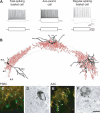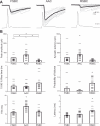Distinct synaptic properties of perisomatic inhibitory cell types and their different modulation by cholinergic receptor activation in the CA3 region of the mouse hippocampus
- PMID: 20529124
- PMCID: PMC2916217
- DOI: 10.1111/j.1460-9568.2010.07292.x
Distinct synaptic properties of perisomatic inhibitory cell types and their different modulation by cholinergic receptor activation in the CA3 region of the mouse hippocampus
Abstract
Perisomatic inhibition originates from three types of GABAergic interneurons in cortical structures, including parvalbumin-containing fast-spiking basket cells (FSBCs) and axo-axonic cells (AACs), as well as cholecystokinin-expressing regular-spiking basket cells (RSBCs). These interneurons may have significant impact in various cognitive processes, and are subjects of cholinergic modulation. However, it is largely unknown how cholinergic receptor activation modulates the function of perisomatic inhibitory cells. Therefore, we performed paired recordings from anatomically identified perisomatic interneurons and pyramidal cells in the CA3 region of the mouse hippocampus. We determined the basic properties of unitary inhibitory postsynaptic currents (uIPSCs) and found that they differed among cell types, e.g. GABA released from axon endings of AACs evoked uIPSCs with the largest amplitude and with the longest decay measured at room temperature. RSBCs could also release GABA asynchronously, the magnitude of the release increasing with the discharge frequency of the presynaptic interneuron. Cholinergic receptor activation by carbachol significantly decreased the uIPSC amplitude in all three types of cell pairs, but to different extents. M2-type muscarinic receptors were responsible for the reduction in uIPSC amplitudes in FSBC- and AAC-pyramidal cell pairs, while an antagonist of CB(1) cannabinoid receptors recovered the suppression in RSBC-pyramidal cell pairs. In addition, carbachol suppressed or even eliminated the short-term depression of uIPSCs in FSBC- and AAC-pyramidal cell pairs in a frequency-dependent manner. These findings suggest that not only are the basic synaptic properties of perisomatic inhibitory cells distinct, but acetylcholine can differentially control the impact of perisomatic inhibition from different sources.
Figures







Similar articles
-
Postsynaptic cell type-dependent cholinergic regulation of GABAergic synaptic transmission in rat insular cortex.J Neurophysiol. 2010 Oct;104(4):1933-45. doi: 10.1152/jn.00438.2010. Epub 2010 Aug 4. J Neurophysiol. 2010. PMID: 20685921
-
Parvalbumin-containing fast-spiking basket cells generate the field potential oscillations induced by cholinergic receptor activation in the hippocampus.J Neurosci. 2010 Nov 10;30(45):15134-45. doi: 10.1523/JNEUROSCI.4104-10.2010. J Neurosci. 2010. PMID: 21068319 Free PMC article.
-
Presynaptic interneuron subtype- and age-dependent modulation of GABAergic synaptic transmission by beta-adrenoceptors in rat insular cortex.J Neurophysiol. 2010 May;103(5):2876-88. doi: 10.1152/jn.00972.2009. Epub 2010 Mar 24. J Neurophysiol. 2010. PMID: 20457865
-
Different output properties of perisomatic region-targeting interneurons in the basal amygdala.Eur J Neurosci. 2017 Feb;45(4):548-558. doi: 10.1111/ejn.13498. Epub 2017 Jan 21. Eur J Neurosci. 2017. PMID: 27977063
-
Dialectics of perisomatic inhibition-The unity and conflict of opposites.Front Neural Circuits. 2024 Oct 29;18:1494300. doi: 10.3389/fncir.2024.1494300. eCollection 2024. Front Neural Circuits. 2024. PMID: 39534761 Free PMC article. Review.
Cited by
-
Kinetics and Connectivity Properties of Parvalbumin- and Somatostatin-Positive Inhibition in Layer 2/3 Medial Entorhinal Cortex.eNeuro. 2022 Feb 16;9(1):ENEURO.0441-21.2022. doi: 10.1523/ENEURO.0441-21.2022. Print 2022 Jan-Feb. eNeuro. 2022. PMID: 35105656 Free PMC article.
-
Bicuculline restores frequency-dependent hippocampal I/E ratio and circuit function in PGC-1ɑ null mice.Neurosci Res. 2022 Nov;184:9-18. doi: 10.1016/j.neures.2022.07.003. Epub 2022 Jul 14. Neurosci Res. 2022. PMID: 35842011 Free PMC article.
-
5-HT3a Receptors Modulate Hippocampal Gamma Oscillations by Regulating Synchrony of Parvalbumin-Positive Interneurons.Cereb Cortex. 2016 Feb;26(2):576-85. doi: 10.1093/cercor/bhu209. Epub 2014 Sep 21. Cereb Cortex. 2016. PMID: 25246509 Free PMC article.
-
The Unified Theory of Neurodegeneration Pathogenesis Based on Axon Deamidation.Int J Mol Sci. 2025 Apr 27;26(9):4143. doi: 10.3390/ijms26094143. Int J Mol Sci. 2025. PMID: 40362380 Free PMC article. Review.
-
Autism-associated neuroligin-3 mutations commonly disrupt tonic endocannabinoid signaling.Neuron. 2013 May 8;78(3):498-509. doi: 10.1016/j.neuron.2013.02.036. Epub 2013 Apr 11. Neuron. 2013. PMID: 23583622 Free PMC article.
References
-
- Aronstam RS, Narayanan TK. Temperature effect on the detection of muscarinic receptor-G protein interactions in ligand binding assays. Biochem. Pharmacol. 1988;37:1045–1049. - PubMed
-
- Behrends JC, ten Bruggencate G. Cholinergic modulation of synaptic inhibition in the guinea pig hippocampus in vitro: excitation of GABAergic interneurons and inhibition of GABA-release. J. Neurophysiol. 1993;69:626–629. - PubMed
-
- Binda F, Bossi E, Giovannardi S, Forlani G, Peres A. Temperature effects on the presteady-state and transport-associated currents of GABA cotransporter rGAT1. FEBS Lett. 2002;512:303–307. - PubMed
Publication types
MeSH terms
Substances
Grants and funding
LinkOut - more resources
Full Text Sources
Miscellaneous

